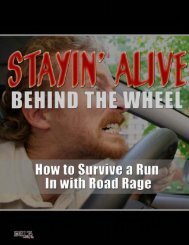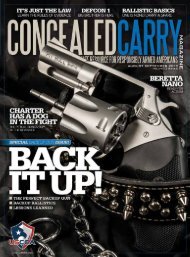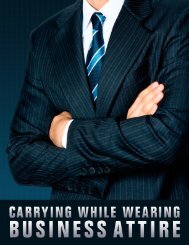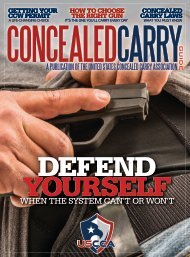Download This Issue - US Concealed Carry
Download This Issue - US Concealed Carry
Download This Issue - US Concealed Carry
Create successful ePaper yourself
Turn your PDF publications into a flip-book with our unique Google optimized e-Paper software.
PHOTOS BY OLEG VOLK • A-HUMAN-RIGHT.COM<br />
left: As Josh Benson<br />
demonstrates, given appropriate<br />
instruction and enough<br />
personal motivation, even<br />
people with severe physical<br />
challenges can become<br />
accomplished shooters and<br />
learn to protect themselves.<br />
above: Bert Rollen tries the new<br />
Keltec RMR30 .22 Magnum<br />
carbine for fit. Despite his<br />
handicap, Bert handles .45 ACP<br />
handguns fine — but prefers<br />
lighter firearms when they are<br />
practical.<br />
The Challenged Shooter<br />
PART I<br />
SHOOTER STAT<strong>US</strong><br />
firearm. Absent such certification, the<br />
instructor may be legally liable for any<br />
negative consequences that may ensue.<br />
In physical terms, how stable is the<br />
shooter? If their disability involves legs,<br />
spine or their sense of balance, their<br />
stability will be affected. <strong>This</strong> impacts<br />
not only their ability to shoot, but the<br />
safety of those around them. If they may<br />
fall while holding the gun, they must be<br />
trained to keep their finger off the trigger<br />
and not tighten their grip while falling,<br />
otherwise a negligent discharge is<br />
waiting to happen. If others are standing<br />
nearby at the time–particularly an<br />
instructor–the odds of someone getting<br />
in the way of that bullet are better than<br />
fair.<br />
If the shooter uses any aids to stand<br />
or walk–crutches, a walking-stick, a<br />
walking-frame, or other device–then<br />
their first priority is to hold onto that<br />
aid while drawing and shooting. There’s<br />
no point in their being able to draw<br />
perfectly, by the numbers, while simultaneously<br />
falling flat on their face!<br />
Also, the use of such supports will usually<br />
prevent the use of both hands to<br />
shoot, so they’re going to have to learn<br />
to shoot one-handed. If they are in a<br />
wheelchair, that simplifies matters, but<br />
only partially. They may need at least<br />
one hand to retain mobility, turning<br />
a wheel to propel themselves toward<br />
cover. If they find themselves in a closequarters<br />
incident (for example, some<br />
MAY/JUNE 2011 n CONCEALED CARRY MAGAZINE n <strong>US</strong>CONCEALEDCARRY.COM<br />
thug comes up behind them and tips<br />
over their wheelchair, prior to grabbing<br />
their handbag or rifling through their<br />
pockets), they may have to use one<br />
hand to brace themselves or push the<br />
wheelchair off themselves, while the<br />
other fends off the attacker or goes for<br />
their gun.<br />
What firearms can<br />
the shooter handle?<br />
Having assessed balance, stance, and<br />
related issues, we now have to look at<br />
the shooter’s ability to handle a defensive<br />
firearm. Many disabilities, particularly<br />
spinal cord injuries, can affect upper<br />
body and arm strength and mobility.<br />
Decreased mobility may imply restric-<br />
43
















